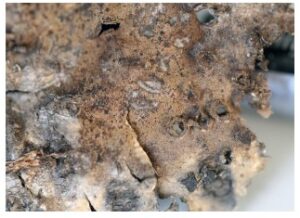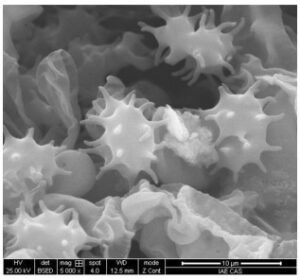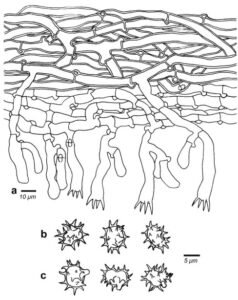Tomentella stipitata H.S. Yuan, X. Lu & Y.C. Dai, sp. nov.
Index Fungorum number: IF 555774; MycoBank number: MB 555774; Facesofungi number: FoF 05645; Figs. 1, 2, 3
Etymology – Refers to the stalked basidia.
Holotype – IFP 019327.
Basidiocarps annual, resupinate, adherent to the substrate, mucedinoid, without odour or taste when fresh, 0.5–0.8 mm thick, continuous. Hymenophoral surface smooth, dark blonde to yellowish brown (5D4–5F8) and turning lighter than subiculum when dry. Sterile margin often indeterminate, farinaceous, dark blonde (5D4). Rhizomorphs absent. Subicular hyphae monomitic; generative hyphae clamped, frequently branched, thick-walled, 5–8 μm diam, without encrustation, pale brown in KOH, acyanophilous, inamyloid. Subhymenial hyphae clamped, thin-walled, occasionally branched, 5–8 μm diam; hyphal cells short and inflated, pale brown in KOH, acyanophilous, inamyloid. Cystidia absent. Basidia 20–50 μm long and 6–9 μm diam at apex, 5–6 μm at base, with a clamp connection at base, utriform, stalked, sinuous, without transverse septa, pale brown in KOH and in distilled water, 4-sterigmate; sterigmata 6–10 μm long and 1.5–2 μm diam at base. Basidiospores thick-walled, (7–)7.5–8.5(–9)×(6–)6.5–8(–8.5) μm, L=7.83 μm, W=6.88 μm, Q=1.06–1.15 (n=60/2), subglobose to bi- or tri-lobed in frontal and lateral views, echinulate, pale brown in KOH and distilled water, cyanophilous, inamyloid; echinuli usually isolated, sometimes grouped in 2 or more, up to 2.5 μm long.
Material examined – CHINA, Liaoning Province, Qingyuan County, Experimental Station of Forest Ecology, on fallen angiosperm branch, 3 August 2016, Yuan 11160 (IFP 019327, holotype), 30 July 2017, Yuan 12143 (IFP 019328).
GenBank numbers – ITS: MK211740, MK211741; LSU: MK446413, MK446414.
Notes – Tomentella bryophila is similar to T. stipitata by the dark blonde to raw umber basidiocarps adherent to the substrate, a smooth hymenophoral surface, a farinaceous sterile margin, clamped hyphae, short and inflated subhymenial hyphal cells, utriform basidia and the absence of rhizomorphs and cystidia. However, T. bryophila differs from T. stipitata by having globose to subglobose basidiospores (Kõljalg 1996). T. asiae-orientalis resembles T. stipitata by basidiocarps adherent to the substrate, a farinaceous sterile margin, clamped hyphae, thick-walled basidiospores and the absence of rhizomorphs and cystidia. However, T. asiae-orientalis differs from T.stipitata by having more or less uniform subhymenial hyphal cells, utriform basidia and globose
to subglobose basidiospores.

Figure 1 – A basidiocarp of Tomentella stipitata (IFP 019327, holotype)

Figure 2 – SEM of basidiospores of Tomentella stipitata (IFP 019327, holotype)

Figure 3 – Microscopic structures of Tomentella stipitata (IFP 019327, holotype). a Section through a basidiocarp. b Basidiospores in frontal view. c Basidiospores in lateral view
